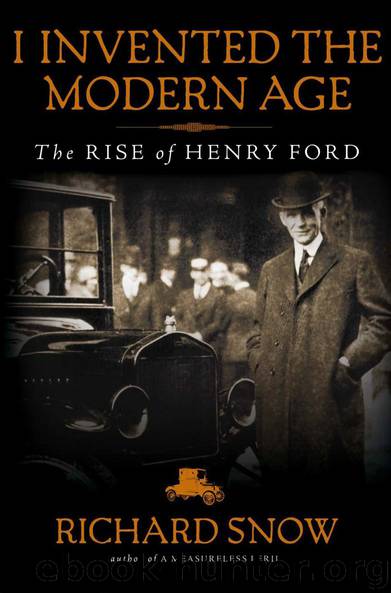I Invented the Modern Age: The Rise of Henry Ford by Richard Snow

Author:Richard Snow [Snow, Richard]
Language: eng
Format: epub, mobi
Publisher: Scribner
Published: 2013-05-13T14:00:00+00:00
CHAPTER 12
Terrible Efficiency
The Crystal Palace; taking the work to the worker; speeding up; the twentieth century’s only industrial revolution; the workers hate it.
Of course the Model T could never have made such an impression had it not been deployed in vast numbers, and at a price folks like Roscoe Sheller’s dairy farmer could afford. That Ford developed a way to do this is, more than the car itself, the measure of his genius.
Several automakers were turning out a hundred cars a day during the Model T’s early years, which demonstrates impressive planning and organization, but as Allan Nevins points out, there is a fundamental difference between “quantity production” and true “mass production.” It was by inventing the latter that Henry Ford invented the modern age.
First, though, he needed a place to invent it in. The success of the Model N had badly strained the Piquette Avenue plant. In 1906, months before the first Model T was built, Ford bought sixty acres of land in Highland Park, a small suburb six miles north of downtown Detroit.
He hired Albert Kahn to design his new factory. The architect was still in his thirties, but he had already built a plant for Packard that impressed Ford with its advanced reinforced concrete design and broad stretches of glass. Ford wanted something bigger, and he got it: the largest building in Michigan and the largest automobile factory in the world. Four stories high and 865 feet long—equivalent to an eighty-six-story skyscraper lying on its side—its concrete corners fortified with steel supporting rods beneath a shell of decorative brick framed fifty thousand square feet of glass. That was three-quarters of the building’s walls, and on fair days the workers would stand in a lake of sunlight so bright that some took to calling the place the Crystal Palace. In a few months Kahn had put up next to this prodigy a machine shop nearly as large, with an all-glass roof. The two buildings were connected by a craneway to carry materials from one to the other. Eight hundred and sixty feet long and nearly sixty high, it was itself a corridor of glass. The Highland Park factory set Kahn on his way to being the foremost industrial architect in America.
Ford operations moved from Piquette Avenue at the end of 1909, “without,” the Ford Times pertly reported, “a brass band, a ball, a clambake, or even a speech from the mayor.” The house organ had a right to its complacency. On the last day of 1909 all the new Ford cars were shipped from Piquette Avenue. On New Year’s Day of 1910, most of them rolled out of Highland Park.
This extraordinarily smooth transition was largely the work of Sorensen and his immediate boss, a French Canadian named Peter Martin whom Nevins describes as “burly” and, somewhat more surprisingly, “stodgy.” Martin was the plant’s superintendent, although he never held that title.
Henry Ford abhorred titles. Sorensen remembered that in the spring of 1908 Ford summoned him and Martin—who was universally known as Ed—to his office.
Download
I Invented the Modern Age: The Rise of Henry Ford by Richard Snow.mobi
This site does not store any files on its server. We only index and link to content provided by other sites. Please contact the content providers to delete copyright contents if any and email us, we'll remove relevant links or contents immediately.
| Civilization & Culture | Expeditions & Discoveries |
| Jewish | Maritime History & Piracy |
| Religious | Slavery & Emancipation |
| Women in History |
Cecilia; Or, Memoirs of an Heiress — Volume 1 by Fanny Burney(32443)
Cecilia; Or, Memoirs of an Heiress — Volume 2 by Fanny Burney(31875)
Cecilia; Or, Memoirs of an Heiress — Volume 3 by Fanny Burney(31859)
The Secret History by Donna Tartt(18865)
Sapiens: A Brief History of Humankind by Yuval Noah Harari(14258)
Leonardo da Vinci by Walter Isaacson(13190)
The Radium Girls by Kate Moore(11935)
Sapiens by Yuval Noah Harari(5298)
How Democracies Die by Steven Levitsky & Daniel Ziblatt(5134)
The Wind in My Hair by Masih Alinejad(5036)
Homo Deus: A Brief History of Tomorrow by Yuval Noah Harari(4828)
Endurance: Shackleton's Incredible Voyage by Alfred Lansing(4686)
The Silk Roads by Peter Frankopan(4462)
Man's Search for Meaning by Viktor Frankl(4439)
Millionaire: The Philanderer, Gambler, and Duelist Who Invented Modern Finance by Janet Gleeson(4386)
The Rape of Nanking by Iris Chang(4142)
Joan of Arc by Mary Gordon(4024)
The Motorcycle Diaries by Ernesto Che Guevara(4021)
Hitler in Los Angeles by Steven J. Ross(3902)
